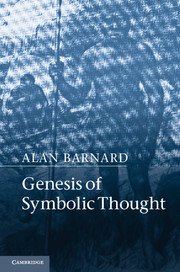7 - After symbolic thought: the Neolithic
Published online by Cambridge University Press: 05 August 2012
Summary
The Neolithic is relevant precisely because with it, so much changed. I have written many times before, for example, about the loss of universal kinship classification (in which all members of a small-scale society are called by specific kinship terms). These systems are found almost everywhere among hunter-gatherers, but hardly anywhere among non-hunter-gatherers. I have written too about changes in economic ideology, and many other social anthropologists have written on these as well. We do not all agree on the details, and we disagree quite strongly on which elements of economic ideology are the most significant. Yet, the collective formulation by hunter-gatherer specialists does hint at ways in which the Neolithic did move us away from what we, all humanity, once shared. We anthropologists can recover something of what is lost among non-hunter-gatherers simply by treating seriously hunter-gatherer universals in light of archaeological material. I believe we can also recover something of earlier times through the comparative exploration of hunter-gatherer difference. This includes things like myth, moon symbolism and so on.
‘Neolithic revolution’ or ‘Neolithic transition’?
The word ‘Neolithic’ was invented by Sir John Lubbock (1865: 1–2) to describe a stone tool tradition in contrast to the Palaeolithic. Mesolithic soon came into use, though first to mean something akin to what is now called Upper Palaeolithic, and only rather later accepted as a description of a phase between the Palaeolithic and the Neolithic. Today, the Palaeolithic of the Near East and Europe is recognized as the long set of traditions from the first pre-Homo sapiens settlers and earliest stone tools to remnant populations living about 10,000 BP. The Mesolithic is recognized as lasting from about 22,000 to 5900 BP, the Neolithic lasted perhaps from 12,700 or 11,500 BP in the Near East to the Bronze Age, about 5300 BP. The dates are a matter of debate, and the end point (especially in northern Europe) is invariably both more difficult to identify and less significant in the minds of archaeologists. Asian and West African tool traditions are similarly labelled, whereas since the 1920s southern and eastern Africa have had their own regionally specific labelling. The African Middle Stone Age is not the Mesolithic but an earlier phase coinciding partly with the European Upper Palaeolithic and partly with the European Middle Palaeolithic (see Table 2.2).
- Type
- Chapter
- Information
- Genesis of Symbolic Thought , pp. 122 - 141Publisher: Cambridge University PressPrint publication year: 2012



